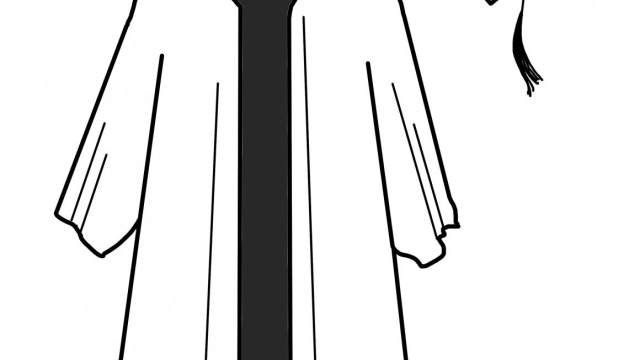Graduation day is a momentous occasion that marks the culmination of years of hard work, dedication, and academic achievement. Amidst the excitement and sense of accomplishment, one iconic symbol stands out – the graduation cap and gown. These timeless symbols encapsulate the significance of the moment, serving as a visual representation of the wearer’s educational journey and the academic community they are now part of.
Steeped in tradition, graduation caps and gowns hold a special place in the hearts of graduates and their loved ones. They serve as a reminder of the countless hours spent studying, the late-night cram sessions, and the challenges overcome. Donning these attire, graduates not only signify their personal success but also pay homage to those who have supported them throughout their educational endeavors.
But graduation caps and gowns are not just mere ceremonial wear. They hold symbolic meanings that extend beyond the surface. The square shape of the cap represents the knowledge and wisdom gained during years of study, while the tassel symbolizes the transition from student to graduate. The flowing gown, worn with pride, reflects the achievement and the honor associated with the completion of an academic journey.
In this comprehensive guide to graduation caps and gowns, we will explore their history, different styles and colors, and the significance they hold for graduates around the world. Whether you’re a soon-to-be graduate looking for essential information or a proud family member seeking to understand the traditions, this guide will provide you with everything you need to know to truly appreciate the significance of these cherished symbols. So, let’s dive in and discover the rich tradition and celebration encapsulated by graduation caps and gowns!
History of Graduation Caps and Gowns
Graduation caps and gowns have a rich history that stretches back centuries. These iconic garments have become a symbol of academic achievement and the completion of one’s educational journey.
During the Middle Ages, universities in Europe began adopting academic dress as a way to distinguish their scholars from the rest of society. This practice was influenced by religious attire and the need for students and professors to be easily recognizable. Initially, the gowns worn during graduation ceremonies were simple and practical, designed to provide warmth in the drafty university halls.
In the 12th century, the tradition of wearing square academic caps, also known as mortarboards, started to emerge. These caps were initially worn by religious scholars and were a symbol of their intellectual authority. Over time, mortarboards became associated with graduation ceremonies as universities embraced them as part of their academic regalia.
The distinctive colors seen on graduation gowns also have historical significance. In the late 19th century, colleges and universities began using colored sashes, hoods, and tassels to signify different fields of study. This tradition originated in the United States and quickly spread to other countries. Today, the specific colors and patterns of graduation regalia vary among institutions, reflecting their unique identities and academic traditions.
Symbolism and Significance of Graduation Attire
The graduation caps and gowns worn by graduates hold immense symbolism and significance. They signify the culmination of hard work, dedication, and achievement that have led up to this special moment. These attire choices go beyond just being stylish or traditional garments – they represent the transformative journey of education.
The graduation cap, also known as a mortarboard, is a symbol of academic accomplishment. Its square shape and the flat board on top represent the knowledge and the solid foundation upon which graduates have built their intellectual pursuits. Wearing the cap tilted to the right signifies the transition from a student to a graduate.
masters graduation cap and gown
The gown, typically made of flowing fabric, holds its own symbolism as well. Its long, flowing design represents the history and tradition associated with the academic institution. The color of the gown often varies based on the degree being conferred, showcasing different fields of study. Whether it is a bachelor’s, master’s, or doctoral degree, the gown serves as a visual proclamation of academic achievement.
Together, the graduation cap and gown create a powerful visual statement of accomplishment and unity among students. They represent a shared sense of pride, reminding graduates of the collective journey they have undertaken and the community they have become a part of. From the moment a graduate dons their cap and gown, they become part of a long-standing tradition that connects them to generations of scholars before them.

In conclusion, graduation caps and gowns hold deep meaning beyond their mere aesthetic. They represent the academic journey, the accumulation of knowledge, and the commencement of a new chapter. Wearing these attire choices during graduation ceremonies allows graduates to honor their achievements while celebrating their commitment to education.
Modern Trends in Graduation Caps and Gowns
As we move forward into the 21st century, graduation caps and gowns have not been immune to the influence of modern trends. Today, they are more than just garments worn during commencement ceremonies; they have become a reflection of personal style and individuality.
One trend that has gained popularity is the customization of graduation caps. Many students are now choosing to embellish their caps with personal messages, quotes, or symbols that hold special meaning to them. These personalized caps serve as a way for graduates to express themselves and stand out amidst the sea of traditional caps.
Additionally, there has been a shift towards more eco-friendly and sustainable materials for graduation gowns. With a growing awareness of the environmental impact of clothing production, some graduates are opting for gowns made from recycled materials or sustainable fabrics. This conscious choice allows them to celebrate their achievements while also making a statement about their commitment to a greener future.
Finally, another modern trend in graduation attire is the incorporation of cultural and ethnic elements. Graduates from diverse backgrounds are embracing their heritage by incorporating traditional patterns, colors, or accessories into their caps and gowns. This celebrates their cultural identity and adds a unique touch to the graduation ceremony as a whole.
The modern trends in graduation caps and gowns highlight the evolving nature of these symbols of achievement. From customized caps to sustainable materials and cultural expressions, graduates today are finding new ways to make their mark on this timeless tradition.





Recent Comments